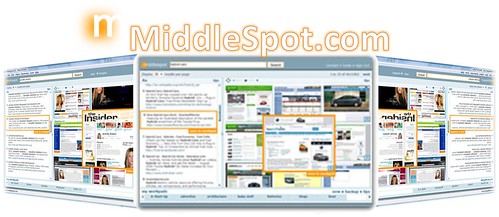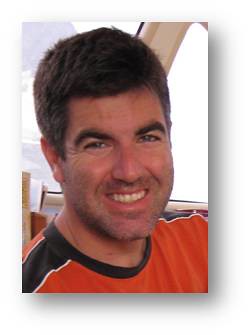
So it is no secret by now, that as recruiters we are really gravitating towards a mobile world, Better known as the “cloud”. The process is nothing new and the majority of us already leverage most of the tools available. As the “mobile recruiter” becomes more widely accepted, so too do search engines that leverage visual aids rather than text. In a recent post I featured and reviewed www.MiddleSpot.com, a search engine that allows you to visually search, edit and share your results.Since than I have continued to use MiddleSpot more effectively and had a chance to catch up with Scott Brownlee from MiddleSpot. We spoke about his new product and how recruiters like you and I can leverage such a valuable tool.
Below is the exchange that took place. Please comment on the interview and let Scott and other readers know your thoughts as well!
Ryan: Scott, first thanks for taking the time to share some information about Middlespot with everyone. I’ve been using Middlespot now for a short while and have quickly grown to like the technology. Tell me a little about yourself and your involvement in Middlespot.
 Scott:
Scott:
Thanks Ryan. I have a bit of an unusual and eclectic story. I grew up in Vancouver, Canada and after university, went to work for Motorola. I was very lucky to be exposed to Internet technologies early on in 1997 and really became passionate about the possibilities. Being young and naive, I started a web development firm (Columbus Group Communications) with two friends from University. We built the business to a little over 100 professionals and sold it to TELUS, the second largest telephone company in Canada. After that, I bought a catamaran and have spent the last 5 years sailing through the Caribbean and the South Pacific. Currently, I’m located in New Caledonia (a small French territory located off the North East Coast of Australia).
Last year, in a visit back home, I connected again with an old partner from my earlier venture, Ken Kwasnicki, a very gifted software engineer. We both really have a passion for the web and had been tossing around ideas for a few years on various projects. That is when Ken approached me with the concept of displaying information in the same way you navigate digital maps. It was a very compelling vision that I wanted to play a part in bringing to reality.
Ryan: So, talk a little about Middlespot and how this idea came to fruition.
Scott: Ken’s initial concept for middlespot was to create a virtual web based global desktop based on an infinitely scalable display grid (a bit of a mouthful). It’s still the core of our long-term vision and where we want to go. But we also recognize that any big web 2.0 vision is built on small, incrementally successful steps, designed to solve a single problem efficiently. We decided to focus our unique grid display interface on the management of a user’s search result, a space that we believe hasn’t really changed in 10 years but is ripe for innovation.
We always try and solve problems we personally have with our experiences on the web. A big problem I often have is evaluating the value of a result, and comparing it to other results in my query. Search engine text results don’t do justice to what’s behind the result, and the linear layout is not conducive to scanning and comparing results quickly. I find that with middlespot, you can scan and compare a lot of results immediately and you are quickly drawn to more personally relevant results. You can also compare the text result and the screenshot of the page, thereby having more information about a site before investing in the time to actually visit it.
Second, a problem I often have is that my searches take place over many days, and are often done for a parent or colleague (I’m sure this happens to a lot of people who are considered the “technology” person in their family). Current search display technology focuses on the ‘right now’ phenomenon and doesn’t recognize the discovery and management activities that take place after those results are presented. Middlespot solves this for me by allowing me to build a collection of results in a personal ‘workpad’ and add to that workpad over time, even when I’m not actually doing a search (through the browser toolbar). I can also share that workpad with people I want to benefit from my hardwork. For example, I can assemble a workpad about photo sharing sites with my personal annotations about each, making it easier for them to choose one to use.
There are a lot of other applications of the middlespot interface that people are coming up with and emailing us daily. This is helping us define new features to implement on middlespot.
Ryan: What about your team?
Scott: I’m very lucky to be involved with some high caliber talent on middlespot. Ken, who I mentioned earlier, brings a wealth of creative open source software development to the team. His approach to development allows us to experiment and deploy features at a tremendous rate. David Birnie brings us strong corporate governance and some healthy grounding towards what is necessary to build a sustainable, successful business from scratch. I believe I bring the skills necessary to bridge the capabilities of technology with the needs of the user.
Being a startup, we really try and manage our time and resources as efficiently as possible. There is a definite benefit to innovation taking place in a constrained environment. If we think we can’t accomplish a piece on our own or don’t see it as a core requirement to our team, we will contract it out or establish a relationship with another web 2.0 provider to add that capability. We really try and work in an iterative model.
Ryan: It’s obvious that you are very passionate about your work. Where do you feel you passion for this project and your portfolio of impressive work came from?
Scott: The Internet creates a fantastic environment to be creative and innovative. I enjoy brainstorming new ideas, but I really love seeing if they can become a reality. To me, execution is the exciting part of any project. Especially when you see a feature or function you’ve invented incrementally improve or simplify a task or activity, and then to see a user have that same ‘aha’ moment.
I feel very lucky that I’ve been able to get myself into a position that I can pursue projects that get me excited. I also love getting involved with people who are infinitely more talented than I am, because I love when they show me the ‘aha’ moment.
Ryan: Can you give me an idea of the backend for Middlespot? Maybe a little insight into the technology and what separates Middlespot from other search competitors?
Scott: As I mentioned earlier, we are focused on simplicity and functionality. We don’t require plugins (such as flash), logins, or passwords to use middlespot. We are making all social aspects of middlespot driven by the permissions of the user, so you don’t share anything you don’t want to share.
We are heavily focused on leveraging the new technologies of web 2.0. Significant portions of middlespot are hosted in the Amazon cloud. Our results are generated from the Yahoo!BOSS API. Our recommendation engine is built using the inSuggest API. All of our application is built using javascript to ensure integrated compatibility with all major browsers. In the next few months, we hope to have integrated drop.io for file uploads, and build out a version for the iphone, blackberry, and android. We also hope to create an API for middlespot workpads so other developers can build on top of what we’ve created.
We really aren’t focused on competitors, although there are some great ones out there. We think viewzi and searchme are pretty interesting. As I said earlier, we don’t really see ourselves as a competitor to any of the major search engines like Google. We think the management of results is a new space that is under serviced right now. To us, it is situational. Sometimes Google is the best tool for finding something quick and dirty, while at other times, middlespot will provide you a more robust tool to really interrogate and manage your research. The effort of search and research on the web has a wide spectrum of activity for the user.

Ryan: Web 2.0; Social Media. What is your take on this movement and how does Middlespot leverage the technology or thought process?
Scott:
Web 2.0 and social media is a very powerful movement in its ability to unlock and democratize information. I think my lifestyle highlights the very potential of what will come through this new creative, social environment. I live on a boat in the South Pacific and am able to collaborate with colleagues in Canada, the US, and Europe. We can interact with each other in real time or through postings and online project management tools that cost little or nothing to maintain. Solutions to programming and design challenges can usually be solved from reading a blog. As well, I use Facebook, Linkedin, MSN Messenger, Skype, Flickr, and Posterous to keep in touch with family around the world. All of this is done at a fraction of the cost it used to be (if it could be done at all).
We really believe we have only begun to scratch the surface of the social potential of middlespot. Right now, you can share a workpad with a friend and colleague, tracking the number of times your workpad has been viewed and creating personal comments around its contents. The potential is far more powerful due to the nature of our grid based visual interface.
Our vision is to create a much more social grid display, working on similar principles to digital cartography. Just as digital maps create a zoomable environment for geographic locations, we think the same can be done for information. You can cluster information (files, images, website links, etc.) on this cartographic plane and give it a place name (for example, research for my thesis). You could build additional clusters of information (another example, family member blogs) that are located adjacent to other. Simply zoom out and you can see it all (similar to your desktop but instead of opening a folder, you zoom in to see its content). Zoom even further out and you will begin to see other clusters of information that have been shared with you (for example, the cluster of employee homepages set up by the head of HR). Basically, you start building out an interconnected network between information based on your relationship to it that is built on the time tested model of cartography. It sounds a bit esoteric right now, but it’s a vision we think achievable.
We like to joke that it will be like SimCity for information. Hopefully just as fun for the user as well.
Ryan: Here is the million dollar question. I’m a sourcer; and the readers at CruiterTak.com are recruiters, staffing mangers, talent mangers and the like. Why do you think Middlespot.com should be in the front of everyone’s mind as an everyday tool? How would you describe its value add?
Scott:
I think middlespot is actually a very valuable tool that recruiters can use, both for the company they are servicing and the talent they are trying to place. Recruiters are matchmakers, and therefore need to introduce both parties as thoroughly as possible. This takes a lot of information.
Using middlespot, a recruiter can search for information and build a workpad around an individual candidate. This workpad can contain a candidate’s linkedin bio page, some information about their previous company, and other appropriate and relevant web content (like a family blog). This information can be shared with the recruiting company, giving them a deeper perspective of this potential candidate. Also, each item in the workpad can have a recruiter’s personal annotations, highlighting positives and concerns that are revealed through each piece of information.
In servicing the candidate, a recruiter can do a similar thing. They can assemble information about the company or companies the candidate is considering, its location, some press releases and even the employees that the candidate would work with. As a recruiter, you are providing a candidate with the most comprehensive overview of their options and opportunities.
And as you discover additional information for either the candidate or the recruiting company, you can simply add a new result to a workpad and it automatically updates the workpad the client is using. You can also see statistics as to how often a workpad has been viewed by a client.
Ryan: So what’s the feedback been like so far and what can we expect to see in the next few years?
Scott:
We’ve had some terrific feedback, especially from teachers and librarians. This gives us the confidence that we really have found a space that hasn’t been serviced by web 2.0 yet.
I think you can expect to see middlespot continue to build out the display technology, maintaining a focus on simplicity and clarity. I can’t really say where that direction will be as we really define our future features based on the feedback we receive. There is no better technology roadmap than the feature requests of your users.
We do plan within the next three months to roll out the following features:
· Workpads that can be collaborative and provide RSS notification when changes are made.
· The ability to upload files, documents, images and videos to your workpad.
· The ability to see your search history in the gallery display.
· Improved zooming of individual screenshots.
· A mobile version of the search display and your workpads, allowing you to access workpad results on your iphone, blackberry or android device.
· A widget version of workpads so you can have them on your igoogle, apple dock, or vista sidebar.
· Drag and drop rearrangement of workpad entries.
· A number of refinements to the interface to improve the usability of each tool.
Ryan: Are you involved in any other projects at this point that you’d like to talk about?
Scott:
I’m involved in some other projects, but mostly from an investment perspective. Middlespot at this point is the focus of my interest from a time commitment.
Ryan: And lastly, I always like to play a game I call rapid fire. I’m going to give you 3 terms or phrases and without thinking, tell me the first thought that comes to mind:
1. Web 2.0
Scott: A wonderfully accessible environment perfect for fostering experimentation and creativity.
2. Social Media
Scott: Staying connected with friends and family in ways I’ve never been able to before. Without it, I don’t think I would have been able to maintain 1/10th of my personal relationships.
3. Social Media, Web 2.0 and the world of search?
Scott: There is a whole new spectrum of activity that has yet to be explored by the user in managing this personal and public information.
Ryan: Ok, I know we are out of time, but in one last breathe: Is there anything you want everyone to know about any happenings we did not speak about?
Scott: I’d like to mention two things;
We would really appreciate any feedback, comments, and feature recommendations. I will respond to every email submitted and feedback is essential to our continued development. [email protected]
Also, we are launching a reciprocal advertising program in January. If you run a blog or website, we will allow you to sponsor keyword searches in middlespot in exchange for placing a middlespot badge on your site. You can see what a premier sponsorship on middlespot looks like at http://www.middlespot.com/advertise.php
Thanks again for taking the time to learn about middlespot.com
PLEASE LET SCOTT KNOW YOUR THOUGHTS ON MIDDLESPOT.COM BY COMMENTING BELOW!
By Noel Cocca
CEO/Founder RecruitingDaily and avid skier, coach and avid father of two trying to keep up with my altruistic wife. Producing at the sweet spot talent acquisition to create great content for the living breathing human beings in recruiting and hiring. I try to ease the biggest to smallest problems from start-ups to enterprise. Founder of RecruitingDaily and our merry band of rabble-rousers.
Recruit Smarter
Weekly news and industry insights delivered straight to your inbox.





